
Dragon is one of the two official magazines for source material for the Dungeons & Dragons role-playing game and associated products, along with Dungeon.
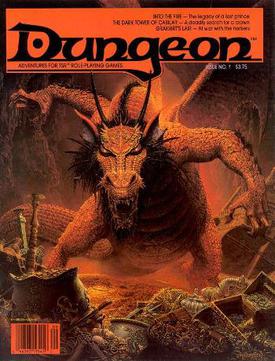
Dungeon was one of the two official magazines targeting consumers of the Dungeons & Dragons role-playing game and associated products; Dragon was the other.
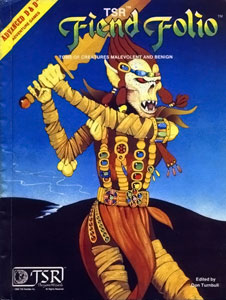
Fiend Folio is the name of three separate products published for successive editions of the fantasy role-playing game Dungeons & Dragons (D&D). All three are collections of monsters.
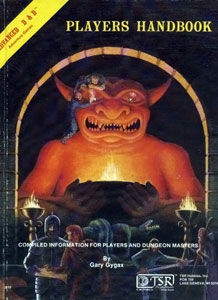
The Player's Handbook is the name given to one of the core rulebooks in every edition of the fantasy role-playing game Dungeons & Dragons (D&D). It does not contain the complete set of rules for the game, and only includes rules for use by players of the game. Additional rules, for use by Dungeon Masters (DMs), who referee the game, can be found in the Dungeon Master's Guide. Many optional rules, such as those governing extremely high-level players, and some of the more obscure spells, are found in other sources.

Ravenloft is an adventure module for the Dungeons & Dragons (D&D) fantasy role-playing game. The American game publishing company TSR, Inc. released it as a standalone adventure booklet in 1983 for use with the first edition Advanced Dungeons & Dragons game. It was written by Tracy and Laura Hickman, and includes art by Clyde Caldwell with maps by David Sutherland III. The plot of Ravenloft focuses on the villain Strahd von Zarovich, a vampire who pines for his lost love. Various story elements, including Strahd's motivation and the locations of magical weapons, are randomly determined by drawing cards. The player characters attempt to defeat Strahd and, if successful, the adventure ends.

Living campaigns, or shared campaigns, are a gaming format within the table-top role-playing game community that provide the opportunity for play by an extended community within a shared universe. In contrast to traditional isolated role-playing games, living campaigns allow and encourage players to develop characters that can be played at games run by many different game masters, but which share a game world and campaign setting, as well as a plot line that is overseen by a central core of professional or volunteer editors and contributors. Many living campaigns serve a dual role of providing a creative outlet for highly involved volunteer contributors while also serving as a marketing tool for the publisher of the game system that is the focus of the living campaign. While the earliest living campaigns were run by the now defunct RPGA, many groups around the world run active living campaigns which are independent or sponsored by other publishers.
Ralph Williams, almost always referred to as Skip Williams, is an American game designer. He is married to Penny Williams, who is also involved with the games industry. He was the co-creator of Dungeons & Dragons 3rd Edition and the longtime author of the "Sage Advice" column for Dragon Magazine.
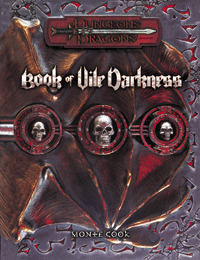
Book of Vile Darkness is an optional supplemental sourcebook for the 3rd edition of the role-playing game Dungeons & Dragons. The book was written by Monte Cook and published by Wizards of the Coast on October 1, 2002. Described as a "detailed look at the nature of evil," it was the first Dungeons & Dragons book labelled for mature audiences.

Sean K. Reynolds is an American professional game designer, who has worked on and co-written a number of Dungeons & Dragons supplements for Wizards of the Coast, as well as material for other companies.
James Daniel Lowder is an American author, anthologist, and editor, working regularly within the fantasy, dark fantasy, and horror genres, and on tabletop role-playing games and critical works exploring popular culture.

Mordenkainen's Fantastic Adventure by Robert J. Kuntz and Gary Gygax is an adventure module for the Dungeons & Dragons role-playing game, published by TSR, Inc. in 1984. It originally bore the code "WG5" and was intended for use with the Advanced Dungeons & Dragons first edition rules. Because it is one of the WG modules, it is a module intended for the World of Greyhawk campaign setting. It was later updated in 2004 to the Third Edition Revised rules in Dungeon magazine, issue #112, as Maure Castle. There were subsequently two additional installments in issues #124 and #139.
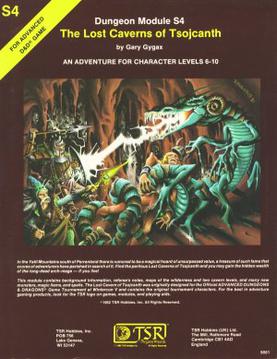
The Lost Caverns of Tsojcanth is an adventure module for the Dungeons & Dragons fantasy role-playing game. It was written by Gary Gygax and published by TSR in 1982 for the first edition Advanced Dungeons & Dragons (AD&D) rules. The 64-page adventure bears the code "S4" and is set in the Greyhawk campaign setting. It is divided into two parts, a 32-page adventure, and a 32-page booklet of monsters and magic items. The plot involves the player characters investigating rumors of lost treasure. After traversing a wilderness and two levels of dungeons, the players face Drelnza, the vampiric daughter of long-deceased archmage Iggwilv.

Stan! is an American author, cartoonist, and game designer. He is sometimes credited as Stan Brown.
Paizo Inc. is an American role-playing game publishing company based in Redmond, Washington, best known for the tabletop role-playing games Pathfinder and Starfinder. The company's name is derived from the Greek word παίζωpaizō, which means 'I play' or 'to play'. Paizo also runs an online retail store selling role-playing games board games, comic books, toys, clothing, accessories and other products, as well as an Internet forum community.

Goodman Games is an American game publisher best known for the Dungeon Crawl Classics series of adventure modules and role-playing game, its science fiction offshoot Mutant Crawl Classics, and Original Adventures Reincarnated, a line of updated, annotated, and expanded republications of classic RPG adventures and supplements, mostly from TSR, Inc.'s Advanced Dungeons & Dragons. Additionally, Goodman Games produces RPGs using versions of the DCC rules for Fritz Leiber's Lankhmar and Jack Vance's Dying Earth settings, under license. The company has also produced licensed adventures for Wicked Fantasy Factory, Judges Guild, Xcrawl, Iron Heroes, Castles and Crusades, and Death Dealer.
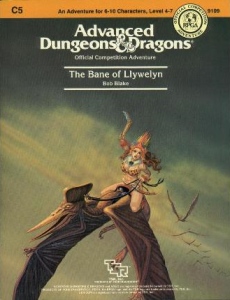
The Bane of Llywelyn is an adventure module for the first edition of the Advanced Dungeons & Dragons fantasy roleplaying game. The adventure was written by Bob Blake and published by TSR in 1985 as part of the Competition, or C-series of modules, and contains material first used in a tournament adventure at GenCon XVI. C5 The Bane of Llywelyn continues the story that started in C4 To Find a King.

Jason Bulmahn is an American game designer who has written or contributed to several works.
Owen K.C. Stephens is a game designer who has worked on a number of products for the Starfinder, Pathfinder and Star Wars Roleplaying Game and other games.
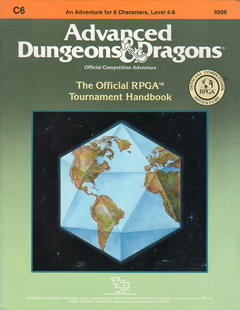
The Official RPGA Handbook is an adventure module for the Dungeons & Dragons fantasy role-playing game, set in the game's World of Greyhawk campaign setting. TSR, Inc. published the module in 1987 for the first edition Advanced Dungeons & Dragons rules. It is part of the "C" series of modules, a set of unrelated adventures originally designed for competition play.















